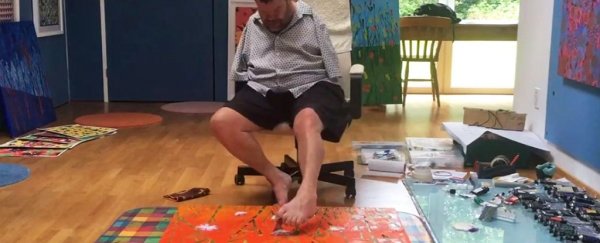In a finding that demonstrates just how amazingly flexible the human brain can be, a new study of two foot painters has revealed that their brains are now mapping their feet almost as if they were hands.
Researchers studied fMRI scans of the two professional UK foot painters born without hands - who also use their feet for everyday tasks such as dressing themselves and using cutlery - during motor activity tasks and sensory experiences. They were compared with scans of a control group of 21 people born with two hands.
The brain scans of the painters revealed individual toes were individually mapped – something that doesn't usually happen in humans. The research also revealed a "hand-like" representation of the feet of the foot painters that wasn't present in the members of the control group.
"For almost all people, each of our fingers is represented by its own little section of the brain, while there's no distinction between brain areas for each of our toes," says neuroscientist Daan Wesselink, from University College London (UCL) in the UK.
"But in other non-human primate species, who regularly use their toes for dexterous tasks like climbing, both the toes and fingers are specifically represented in their brains. Here, we've found that in people who use their toes similarly to how other people use their fingers, their toes were represented in their brains in a way never seen before in people."
These are known as somatotopic maps: specific parts of the body matching up with specific parts of the brain. Like most people born without hands, the foot painters generally use one foot for stability and one foot for actually holding and manipulating objects, and these maps were more distinct for the foot that was more active.
The researchers think that constant use of the feet for complicated tasks might be the reason for this shift in brain development – that the brain adapts if we're doing more with our feet than just walking around on them.
 (UCL)
(UCL)
What's more, the area of the brain that corresponded with the toes of the foot painters was the same area that usually manages the hands. This backs up previous research from the same lab showing that the brain's 'hand area' can support body parts compensating for some kind of disability.
"Our study demonstrates an extreme example of the brain's natural plasticity, as it can organise itself differently in people with starkly different experiences from the very beginning of their lives," says neuroscientist Tamar Makin, from UCL.
One other finding from the study was that the foot painters weren't any better at wiggling their toes than the control group, surprisingly. However, they did show heightened sensory perception for their toes.
The researchers suggest that this brain remapping might be something we're all capable of – it's just that most of us don't need to use it. While brain maps are often consistent across people, it's also true that most people behave in similar ways.
We can add this to the pile of intriguing new discoveries that scientists are making about the brain – from the way that consciousness moves through it, to the minute physical structures that make up this essential and deeply complex organ.
"I've enjoyed helping science by demonstrating how most people's feet are not used to their full potential, and I hope the results will encourage other people to consider unconventional ways to get by without the use of hands," says Longstaff, one of the foot painters involved in the study.
The research has been published in Cell Reports.
